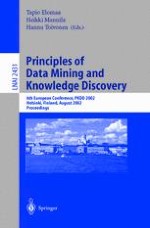2002 | Buch
Principles of Data Mining and Knowledge Discovery
6th European Conference, PKDD 2002 Helsinki, Finland, August 19–23, 2002 Proceedings
herausgegeben von: Tapio Elomaa, Heikki Mannila, Hannu Toivonen
Verlag: Springer Berlin Heidelberg
Buchreihe : Lecture Notes in Computer Science
Enthalten in: Professional Book Archive
